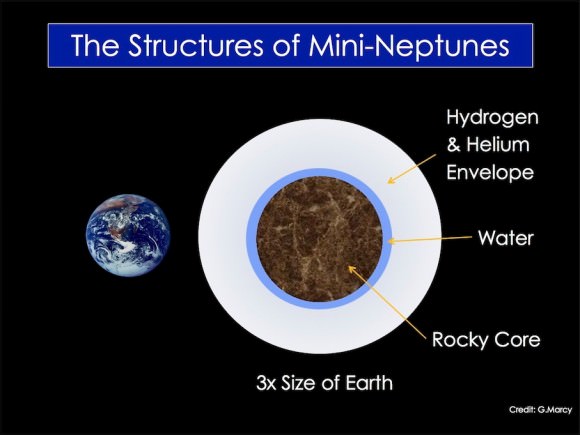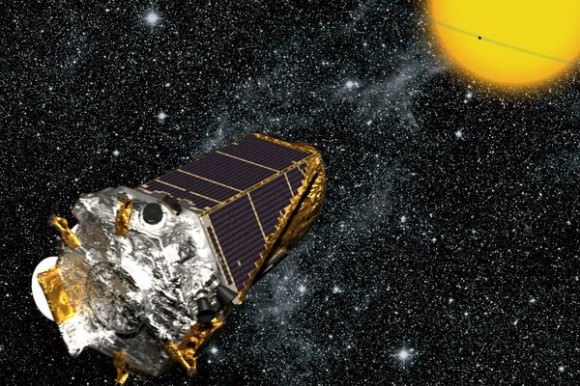If the dataset from the Kepler mission is any indication, the most common type of exoplanets in our galaxy aren’t Earth-sized rocky worlds or hot Jupiters. In fact, the most common type of exoplanet isn’t one that we see in our own neighborhood at all.
“Perhaps the most remarkable discovery by Kepler is the amount of planets between the size of Earth to four times the size of Earth,” said Geoff Marcy, professor of astronomy at University of California, speaking at the American Astronomical Society meeting this week in Washington D.C. “This is a size range that dominates the planet inventory from Kepler and it a size range not represented in our own Solar System. We don’t know for sure what these planets are made of and we don’t know how they form.”
These “mini-Neptunes” as Marcy called them, represent a huge sample in the Kepler data; about 75% of the planets found by Kepler vary in size between the Earth and Neptune, and for four years since the Kepler data have been rolling in, scientists have been trying to understand these planets.
“There’s been an enormous amount of measurements and quantitative work by the NASA Ames Kepler team,” Marcy said.
While masses and planet densities emerged from the work, astronomers still aren’t certain how they form or if they are made of rock, water or gas.

Credit: Geoff Marcy
The team focused on about 42 of these planets. Two planets highlighted by Marcy in his presentation are thought to be rocky, and are named Kepler-99b and Kepler-406b. Both are forty percent larger in size than Earth and have a density similar to lead. The planets orbit their host stars in less than five and three days respectively, making these worlds too hot for life as we know it.
The team used Doppler measurements of the planets’ host stars to measure the reflex wobble of the host star, caused by the gravitational tug on the star exerted by the orbiting planet. The measured wobble reveals the mass of the planet: the higher the mass of the planet, the greater the gravitational tug on the star and hence the greater the wobble.
They also the measured transit timing variations (TTV) to determine how much neighboring planets can tug on one another causing one planet to accelerate and another planet to decelerate along its orbit.
These measurements allow for computing mass and densities of the planets, as well as figuring out the possible chemical composition of these worlds. The majority of the measurements suggest that the mini-Neptunes have a rocky core but some may have a gaseous outer shell of hydrogen or helium. Some might just be rocky with no outer envelope at all.
“What we think is happening is that some of these planets may have water on top of a rocky core,” Marcy said. “Larger planets might have the same rocky core with added gas. That’s how you get planets measuring from 1 to 4 earth radii. The planets with lower densities imply increasing amounts of gas on top of a rocky core.”

“Kepler’s primary objective is to determine the prevalence of planets of varying sizes and orbits. Of particular interest to the search for life is the prevalence of Earth-sized planets in the habitable zone,” said Natalie Batalha, Kepler mission scientist at NASA’s Ames Research Center. “But the question in the back of our minds is: are all planets the size of Earth rocky? Might some be scaled-down versions of icy Neptunes or steamy water worlds? What fraction are recognizable as kin of our rocky, terrestrial globe?”
The team said that the mass measurements produced by Doppler and TTV will help to answer these questions. The results hint that a large fraction of planets smaller than 1.5 times the radius of Earth may be comprised of the silicates, iron, nickel and magnesium that are found in the terrestrial planets here in the Solar System.
Armed with this type of information, scientists will be able to turn the fraction of stars harboring Earth-sizes planets into the fraction of stars harboring bona-fide rocky planets. And that’s a step closer to finding a habitable environment beyond the Solar System.
Marcy added later in the discussion that there’s one type of telescope that would most helpful: a Terrestrial Planet Finder type mission that would measure the temperature, size, and the orbital parameters of planets as small as our Earth in the habitable zones of distant solar systems. Alas, TPF was canceled.
Read more about the study of mini-Neptunes here.


Parallel Earth’s? I can imagine a scenario where a ‘mini Neptune’ has it’s outer atmosphere stripped by the solar winds of a young and turbulent star, leaving a salty liquid water ocean covering a rocky core….
hi,
can you, please, specify what is the difference between the blue and the yellow dots in the chart?
thanks
could it be that earth was also “neptune-like” at first and that it lost its hydrogen/helium envelope as a result of the clash that yielded also the moon?